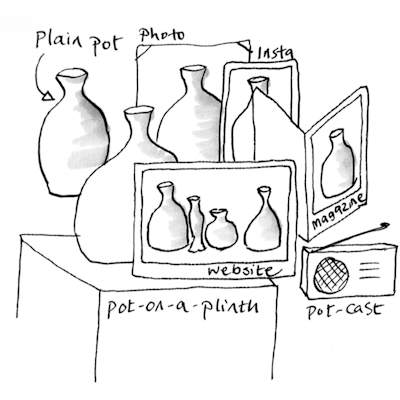Nikkan Woodhouse on craft and the many lenses of meaning.

The theme of ‘lenses’ got me thinking – not about optometry, but about optics. About how we see craft today and how what we see is hugely informed by how we view it.
There’s the object. And then, there’s the story we tell about it.
Craft used to be simpler. Most importantly touched, used, lived with. The hierarchy of ‘good’ was based on durability, efficacy, how nice it felt to use and hold and if it was super pleasing to look at. Craft now can be swiped past, double tapped, scrolled-on, and the crafted object becomes ever more distant and intangible as its cloned troops are sent out into the world in the form of images and narrative.
We live in a communications environment, where the image of the object often holds more currency than the object itself. It’s not that the handmade bowl isn’t beautiful – it’s just that its photograph, moodily lit and amply hash-tagged, might be more widely seen, shared and sold. It’s a digital layering that has wrapped itself around many aspects of our ‘live’ world and, whilst it gives an interesting patina and depth to works, it can become extreme and conceptual. Resonant perhaps of NFTs in the art world; tradable tokens of value, representing digital assets, representing content. Quite a complex mille feuille of narrative, branding, identity and worth!
I was reminded of this, quite viscerally, last week during a visit to the New Designers graduate show in London. A glorious assault of creativity and making; from biodegradable wedding dresses to 3D-printed lamps representing REM sleep patterns. I was there as part of a judging panel – so the first sweep of the exhibition was clean, pure, unfiltered. Light on artist statements and QR codes. Objects minimalistically presented.
We awarded our prize to a young jeweller whose work spanned an astonishing spread of materials: recycled paper, silver, gourd, and (yup) cricket poo. It was playful and skilful and strange in that thrilling way where you can’t quite tell if you’re supposed to laugh, or feel moved, or just a bit awed.
En route home the layering began as I flicked through social media feeds, websites, press: The Aftermath. My sense of the work shifted. Not diminished – just altered. One necklace, entitled Disappointment, had been made from the remains of a failed essay – shredded into tiny fragments and rolled into balls before being set into delicate silver bezels. In person, it was textured and emotive. Online, modelled on a dewy-skinned youth against minimalist backdrops, it became ethereal, almost editorial.
And then there was the Instagram feed: a whole year of necklaces charting seasons, materials, moods – persimmon, blossom, pumpkin, heartbreak. The context re-cast each object. The lens didn’t distort; it revealed. And I started to wonder – where does the value now really lie? In the object? The story? The maker’s identity? The algorithm? There’s a new hierarchy in town. Useful and durable still matter, sure. But so does ‘conceptually engaging’. ‘Exciting/ different’. ‘Photogenic’. We once asked, “Does it work?” Now we ask, “What does it mean?”
Which isn’t to say that the old values are gone – just that they’ve been joined by new ones. Craft today is as much about communication as it is about construction. It’s object and image. Function and feed. Matter and meaning.
So next time you pick up a pot, or scroll past a pair of earrings made from reclaimed bus tickets and saffron threads, take a moment. You’re not just seeing a thing. You’re seeing through it – through a lens, or several. And each one brings a new story into focus.
